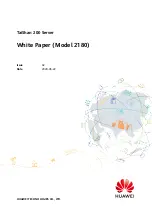
304
Parameters
acl6-number
: Basic IPv6 ACL number, in the range of 2000 to 2999. When an IPv6 ACL is defined, the
source
keyword in the
rule
command specifies a legal BSR source IPv6 address range.
Description
Use
bsr-policy
to configure a legal BSR address range to guard against BSR spoofing.
Use
undo bsr-policy
to remove the restriction of the BSR address range.
By default, no restrictions are defined for the BSR address range. Namely, the BSR messages from any
source are considered eligible.
Examples
# Configure a legal BSR address range so that only devices on the segment 2001::2/64 can become the
BSR.
<Sysname> system-view
[Sysname] acl ipv6 number 2000
[Sysname-acl6-basic-2000] rule permit source 2001::2 64
[Sysname-acl6-basic-2000] quit
[Sysname] pim ipv6
[Sysname-pim6] bsr-policy 2000
c-bsr (IPv6 PIM view)
Syntax
c-bsr
ipv6-address
[
hash-length
[
priority
] ]
undo c-bsr
View
IPv6 PIM view
Default level
2: System level
Parameters
ipv6-address
: IPv6 address of the interface that will act as a C-BSR.
hash-length
: Hash mask length, in the range of 0 to 128. If you do not specify this argument, the
corresponding global setting is used.
priority
: Priority of the C-BSR, in the range of 0 to 255. A larger value means a higher priority. If you do
not specify this argument, the corresponding global setting is used.
Description
Use
c-bsr
to configure the specified interface as a C-BSR.
Use
undo c-bsr
to remove the related C-BSR configuration.
No C-BSR is configured by default.
You must enable IPv6 PIM-SM on the interface that you want to configure as a C-BSR.
Related commands:
c-bsr hash-length
,
c-bsr priority
,
c-rp
, and
pim ipv6 sm
.
















































